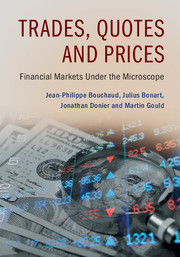Book contents
- Frontmatter
- Dedication
- Contents
- Preface
- Acknowledgements
- PART I HOW AND WHY DO PRICES MOVE?
- PART II LIMIT ORDER BOOKS: INTRODUCTION
- PART III LIMIT ORDER BOOKS: MODELS
- PART IV CLUSTERING AND CORRELATIONS
- PART V PRICE IMPACT
- PART VI MARKET DYNAMICS AT THE MICRO-SCALE
- PART VII ADVERSE SELECTION AND LIQUIDITY PROVISION
- PART VIII MARKET DYNAMICS AT THE MESO-SCALE
- PART IX PRACTICAL CONSEQUENCES
- Appendix
- Index
PART VII - ADVERSE SELECTION AND LIQUIDITY PROVISION
Published online by Cambridge University Press: 26 February 2018
- Frontmatter
- Dedication
- Contents
- Preface
- Acknowledgements
- PART I HOW AND WHY DO PRICES MOVE?
- PART II LIMIT ORDER BOOKS: INTRODUCTION
- PART III LIMIT ORDER BOOKS: MODELS
- PART IV CLUSTERING AND CORRELATIONS
- PART V PRICE IMPACT
- PART VI MARKET DYNAMICS AT THE MICRO-SCALE
- PART VII ADVERSE SELECTION AND LIQUIDITY PROVISION
- PART VIII MARKET DYNAMICS AT THE MESO-SCALE
- PART IX PRACTICAL CONSEQUENCES
- Appendix
- Index
Summary
Introduction
Throughout the book, we have pieced together several clues that suggest that the unpredictable nature of prices emerges from a fine balance between a strongly auto-correlated order flow and a dynamic price impact. At the same time, however, we have seen that so-called surprise models can also reproduce this balance with very few assumptions. It therefore seems that there might be another side to the coin, which statistical models fail to capture. Are we missing something?
So far, we have regarded order flows as simple stochastic processes with specified statistical properties. In doing so, we have excluded the strategic behaviours implemented by real market participants. In reality, however, investors’ actions are clearly influenced by their desire to make profits. Therefore, it seems logical that strategic behaviour should play an important role in real markets.
In this part, we will take the next logical step in our journey by exploring how including strategic considerations can shed light on some otherwise surprising features of financial markets. In doing so, we will examine how markets can remain in a delicate balance, maintained by ongoing competition between rational, profit-maximising agents. We will discuss the seminal Kyle model, which provides a beautiful explanation of how impact arises from liquiditya providers’ fears of adverse selection from informed traders. The model illustrates how impact allows information to be reflected in the price, and makes clear the important role played by noise traders – as we alluded to in the very first part of this book. More generally, the Kyle model, albeit not very realistic, is a concrete example of how competition and arbitrage can produce diffusive prices, even in the presence of private information.
Economic models also provide important insights on the challenges faced by market-makers. We will discuss the work of Glosten and Milgrom, which shows how the bid–ask spread must compensate market-makers for adverse selection in a competitive market. The relationship between a metaorder's slippage and its permanent impact will appear as another manifestation of the same idea. This framework paves the way for richer models of liquidity provision, where inventory risk, P&L skewness and finite tick-size effects all contribute to the challenge. We will also discuss how the Glosten–Milgrom model teaches us an important lesson: that the apparent profit opportunities from “buying low, selling high” around the spread are completely misleading.
- Type
- Chapter
- Information
- Trades, Quotes and PricesFinancial Markets Under the Microscope, pp. 287 - 289Publisher: Cambridge University PressPrint publication year: 2018



